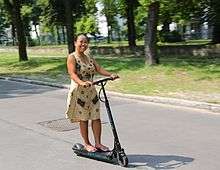Kick scooter
A kick scooter (also referred to as a push-scooter or scooter) is a human-powered street vehicle with a handlebar, deck, and wheels propelled by a rider pushing off the ground. Today, the most common scooters are made of aluminum, titanium, and steel. Some kick scooters made for younger children have 3 to 4 wheels (but most common ones are known to have 2 wheels) and are made of plastic or don't fold. High-performance racing scooters made for adults resemble the old "penny-farthing".[1]
Motorized scooters, historically powered by gas engines, and more recently electric motors, are self-propelled kick scooters capable of speeds of around 30 km/h (19 mph).
Models and history
.jpg)
Early scooters
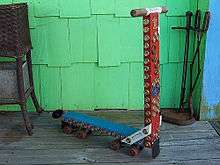
Kick scooters have been handmade in industrial urban areas in Europe and the United States since the 1920s or earlier, often as play items made for children to roam the streets.[2] One common home-made version is made by attaching roller skate wheelsets to a board with some kind of handle, usually an old box.[3] Riders can lean to turn, or by using a second board connected by a crude pivot. The construction was all wood, with 3–4 inch (75–100 mm) wheels with steel ball bearings. An additional advantage of this construction was a loud noise, just like from a "real" vehicle. An alternative construction consists of one steel clamp on a roller skate divided into front and rear parts and attached to a wood beam.
The German Bundesarchiv for "roller" details that both homemade and manufactured children's scooters were used and even raced in Paris, Berlin and Leipzig in 1930, 1948 and 1951. They are similar to later designs.
The short movie "A Trip Through the Streets of Amsterdam" from 1922 shows a number of children on scooters.[4]
Kick scooter
In 1974, the Honda company made the Kick 'n Go, a scooter driven by a pedal on a lever.[5] While it seemed to be as much effort to "kick" as a regular scooter, the novelty of it caught on and it became popular nevertheless.[6]
Pneumatic tires
Before bicycles became popular among children, steel scooters with two small bicycle wheels were more common. Around 1987, many BMX manufacturers produced BMX-like scooters as, such as Scoot.[7] Those manufacturers discontinued their scooters, but some scooter manufacturers were established in later years and remain in business; some are still used in dense urban areas for utility purposes, since they are faster than a folding scooter and more convenient than a utility bicycle. Some are made for off-road use and are described as mountain scooters. In addition to commuting, sports competition, and off-road use, large wheel scooters are a favorite for dog scootering, an activity in which single or team dogs such as huskies pull a scooter and its rider in the same way that a sled is pulled across snow. Some Amish are not allowed to ride bicycles, so they ride scooters instead.[8] Today, variations on the kicksled with scooter design features are also available, such as the Kickspark.[9]
Kickbike
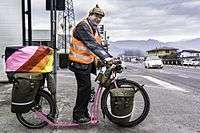
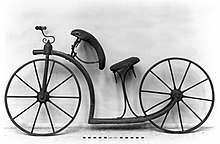
The development of the kickbike in Finland in 1994 changed the way scooters are viewed. The Kickbike has a large standard size bicycle front wheel and a much smaller rear wheel, which allows for a much faster ride. The Footbike Eurocup has been held since 2001.[10]
Folding scooters
In 1996, a foldable aluminium scooter with inline skates wheels was created by Wim Ouboter of Micro Mobility Systems in Switzerland.[11][12] The scooter was sold as "Micro Skate Scooter," "Razor," and "JDBUG/JDRAZOR MS-130A".[13] The Razor was introduced to Japan in 1999, with many early adopters being young Japanese people who used it for portable transport. It later became a worldwide fad and small scooters also became popular toys for children.[14]
Pro scooters
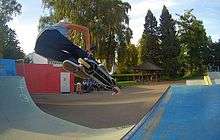
Kick scooters used for extreme sport stunts and tricks and made to withstand stresses and frustrations, are called pro scooters. Numerous brands specialize in stunt scooters and accessories including helmets, pegs, grind wax, griptape clamps, and clothing.[15]
 Early Razor scooter with 98mm wheels
Early Razor scooter with 98mm wheels Folded Razor scooter
Folded Razor scooter A Mini Micro scooter with three wheels
A Mini Micro scooter with three wheels- Xootr scooters in the USA
Three wheels
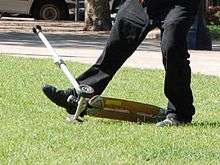
Three-wheeled scooters similar to tricycles have been produced for little children.[16]
In 1999, Micro Mobility Systems and K2 Sports produced a reverse-three-wheeled scooter called "Kickboard." Micro also produced the Kickboard-like children's scooters "Mini Micro" and "Maxi Micro." The reverse design inherently provides greater stability than the standard: a standing person will tend to stand at the front of a scooter rather than at the back. However, the steering geometry is inherently weak and requires design adaptation to improve its response. An example is the Mini Micro, which uses a spring-loaded system to translate lateral force on the handbars (child leaning) into turning motion on the wheels, referred by its makers as "lean and steer."
Four wheels
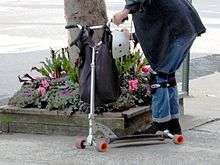
The early scooters, which were made with roller skates, were four-wheeled like skateboards.
Around 2000, a Swiss company produced a four-wheeled scooter called "Wetzer Stickboard." The Wetzer Stickboard was a narrow skateboard with a foldable pole on the nose.[17]
In 2006, a company called Nextsport started producing a line of four-wheeled scooters, known as Fuzions. Fuzion scooters are typically bigger and heavier than Razor and Micro models. The early Fuzion models come with large, wide wheels, and an oversized deck for carving stability. Later scooters, such as the Fuzion NX, include smaller, harder wheels, and 360 degree handlebar spinning capabilities, unlike its predecessors.
Difference from bicycles

Unlike a kick scooter, a bicycle has a seat and drive train, which add speed, cost, weight, and bulk. A folding scooter can be more easily carried than a folding bicycle or even a portable bicycle. Even a non-folding scooter is easier to maneuver between obstacles, since there are no protruding pedals. A bicycle has its advantages on longer journeys and open spaces, while a kick scooter is easier to use for shorter distances and in more crowded locations. Kick scooters seldom have a luggage rack, so the rider usually carries any cargo on his back.
At low speeds a bicycle is difficult to control while pedalling, which is why cyclists occasionally kick their way through dense traffic or in other conditions where they cannot take advantage of the speed of their machines. Thanks to the low-speed stability of a kick scooter, it is allowed on many footpaths where riding a bicycle is forbidden.
Since the feet are nearer to the ground on a scooter, it is easier to step on and off than on a step-through frame bicycle. Hence, the rider can alternate between walking and pushing as energy and route dictate. Large-wheel scooters afford a more effective cross training workout than standard bicycles as the whole body is engaged in the effort of kicking. Although the bicycle is a much more effective and efficient long distance machine, in 2001 Jim Delzer propelled a kick scooter across the United States.[19]
See also
- Chukudu - A freight vehicle in the Democratic Republic of the Congo
- Electric skateboard
- Freestyle scootering
- Wiggle scooter
References
- "Kick dictionary definition - kick defined".
- There is a scene of this in Fritz Lang's 1931 classic M.
- "Skateboarding - Skateboarding Games". crazyskateboardinggames.com. Archived from the original on 2012-05-27. Retrieved 2012-06-28.
- https://www.youtube.com/watch?v=Kh4eVoqUoXo
- "Honda Kick-n-Go Scooter". Honda Kick-n-Go Scooter.
- "1974 Honda Kick 'N' Go". Old Bike.
- GT Zoot Scoot, Mongoose Pro Miniscoot, and SE Racing Rad Scoot.
- "How do Amish travel?". amishamerica.com.
- "Kickbike Worldwide". Kickspark MAX kicksled.
- Eurocup race results, IKSA world, 2001, archived from the original on 2011-07-13.
- "The Micro Scooter History". YouTube. 15 December 2011.
- "Inventor of the micro scooter". The Guardian. 2002-03-31..
- JDRAZOR MS-130A, JD Japan, archived from the original on 2010-08-31.
- "culture.bicycle.birdybike.general - Folding Scooter Story - msg#00015 - Recent Discussion OSDir.com". osdir.com. Archived from the original on 2012-03-20.
- "SkateHut". About Us.
- "Scooter Review Online". Best 3 Wheel Scooters – Guide to Get the Right Model for kids and Adults!.
- "WGD /WGD Awards /red dot award".
- "The History of The Motorized Electric Scooter". February 2010. Retrieved December 4, 2018.
- "Delzer first to cross US on a kickbike". suewidemark.com.
External links
![]()
